Defining Cognitive Reserve and Implications for Cognitive Aging
- PMID: 30627880
- PMCID: PMC7812665
- DOI: 10.1007/s11910-019-0917-z
Defining Cognitive Reserve and Implications for Cognitive Aging
Abstract
Purpose of review: The aim of this review is to summarize current conceptual models of cognitive reserve (CR) and related concepts and to discuss evidence for these concepts within the context of aging and Alzheimer's disease.
Recent findings: Evidence to date supports the notion that higher levels of CR, as measured by proxy variables reflective of lifetime experiences, are associated with better cognitive performance, and with a reduced risk of incident mild cognitive impairment/dementia. However, the impact of CR on longitudinal cognitive trajectories is unclear and may be influenced by a number of factors. Although there is promising evidence that some proxy measures of CR may influence structural brain measures, more research is needed. The protective effects of CR may provide an important mechanism for preserving cognitive function and cognitive well-being with age, in part because it can be enhanced throughout the lifespan. However, more research on the mechanisms by which CR is protective is needed.
Keywords: Aging; Alzheimer’s disease; Biomarkers; Cognition; Cognitive reserve; Review.
Conflict of interest statement
Figures

References
-
- Association, As. 2018 Alzheimer’s disease facts and figures. Alzheimers Dement. 2018;14:367–429.
-
-
Boyle PA, Yu L, Wilson RS, Leurgans SE, Schneider JA, Bennett DA. Person-specific contribution of neuropathologies to cognitive loss in old age. Ann Neurol. 2018;83:74–83
Large study that examines the association between common neuropathologies and rate of cognitive decline prior to death on an individual level; showed that neuropathology is ubiquitous among older adults and more than 230 different combinations of neuropathologies were observed across subjects.
-
-
- Nascimento C, Di Lorenzo Alho AT, Bazan Conceicao Amaral C, Leite REP, Nitrini R, Jacob-Filho W, et al. Prevalence of transactive response DNA-binding protein 43 (TDP-43) proteinopathy in cognitively normal older adults: systematic review and meta-analysis. Neuropathol Appl Neurobiol. 2018;44: 286–97. - PMC - PubMed
Publication types
MeSH terms
Grants and funding
LinkOut - more resources
Full Text Sources
Medical
Research Materials

